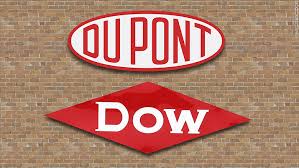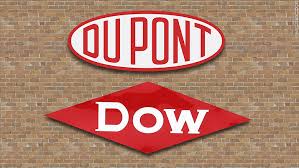
In a win for activist investors that could spark further consolidation in the farm chemicals industry, chemical giants DuPont and Dow Chemical Co agreed to merge in an all-stock deal valuing the combined company at $130 billion.
The ultimate aim of the two companies is to eventual split-up of the combined company into three discrete businesses, Dow and DuPont said on Friday.
However given an extensive overlap of their agriculture businesses, this aim is likely to face intense regulatory scrutiny. Businesses focused on agriculture, materials and specialty products would be created by the proposed split.
The new company would be called DowDuPont in which existing shareholders of Dow and DuPont, excluding preferred shares, will each own about 50 percent of the combined company.
Dow Chemical CEO Andrew Liveris will be executive chairman and DuPont Chief Executive Ed Breen will be CEO of the new company.
While DuPont shareholders will get 1.282 shares in DowDuPont for each DuPont share they own, Dow Chemical shareholders will get one DowDuPont share for each Dow Chemical share held.
A rejig of assets based on the diverging fortunes of their businesses that make agriculture chemicals and plastics would be done by Dow and DuPont following the one of the biggest merger of the year.
The falling crop prices and a strong dollar have resulted in a situation where both the companies have been struggling to cope with falling demand for farm chemicals. However the low natural gas prices helped their plastics businesses to thrive.
"This transaction is a game-changer for our industry and reflects the culmination of a vision we have had for more than a decade to bring together these two powerful innovation and material science leaders," Liveris said in a statement.
The deal is expected to close in the second half of 2016 and the company representatives said that the split would "occur as soon as feasible" which would likely happen 18-24 months after the deal closes.
Dow and DuPont said that the new entity would be able to save about $3 billion in costs in the first two years and potentially another $1 billion in the third year.
The material science company would be the biggest of the three new companies by revenue and it would cater to the packaging, transportation and infrastructure industries. In 2014, the two companies recorded combined revenue for the materials business of $51 billion.
With combined adjusted revenue of about $13 billion in 2014, the new specialty products company would focus on electronics.
Adjusted revenue of about $19 billion was generated from the third business - selling seed and crop protection chemicals.
As falling crop prices curb sales, the merger would put further pressure on rivals such as Germany's BASF SE and Bayer AG to consolidate. The deal could also start a slew of takeover bids for European rivals and it is expected that Syngenta AG would be the most likely target.
It is also a probability, according to experts, that the deal would also put Monsanto Co under pressure to consolidate and might even try and acquire Syngenta, a $45 billion deal that Monsanto had walked out of in August.
(Source:www.reuters.com)
The ultimate aim of the two companies is to eventual split-up of the combined company into three discrete businesses, Dow and DuPont said on Friday.
However given an extensive overlap of their agriculture businesses, this aim is likely to face intense regulatory scrutiny. Businesses focused on agriculture, materials and specialty products would be created by the proposed split.
The new company would be called DowDuPont in which existing shareholders of Dow and DuPont, excluding preferred shares, will each own about 50 percent of the combined company.
Dow Chemical CEO Andrew Liveris will be executive chairman and DuPont Chief Executive Ed Breen will be CEO of the new company.
While DuPont shareholders will get 1.282 shares in DowDuPont for each DuPont share they own, Dow Chemical shareholders will get one DowDuPont share for each Dow Chemical share held.
A rejig of assets based on the diverging fortunes of their businesses that make agriculture chemicals and plastics would be done by Dow and DuPont following the one of the biggest merger of the year.
The falling crop prices and a strong dollar have resulted in a situation where both the companies have been struggling to cope with falling demand for farm chemicals. However the low natural gas prices helped their plastics businesses to thrive.
"This transaction is a game-changer for our industry and reflects the culmination of a vision we have had for more than a decade to bring together these two powerful innovation and material science leaders," Liveris said in a statement.
The deal is expected to close in the second half of 2016 and the company representatives said that the split would "occur as soon as feasible" which would likely happen 18-24 months after the deal closes.
Dow and DuPont said that the new entity would be able to save about $3 billion in costs in the first two years and potentially another $1 billion in the third year.
The material science company would be the biggest of the three new companies by revenue and it would cater to the packaging, transportation and infrastructure industries. In 2014, the two companies recorded combined revenue for the materials business of $51 billion.
With combined adjusted revenue of about $13 billion in 2014, the new specialty products company would focus on electronics.
Adjusted revenue of about $19 billion was generated from the third business - selling seed and crop protection chemicals.
As falling crop prices curb sales, the merger would put further pressure on rivals such as Germany's BASF SE and Bayer AG to consolidate. The deal could also start a slew of takeover bids for European rivals and it is expected that Syngenta AG would be the most likely target.
It is also a probability, according to experts, that the deal would also put Monsanto Co under pressure to consolidate and might even try and acquire Syngenta, a $45 billion deal that Monsanto had walked out of in August.
(Source:www.reuters.com)





